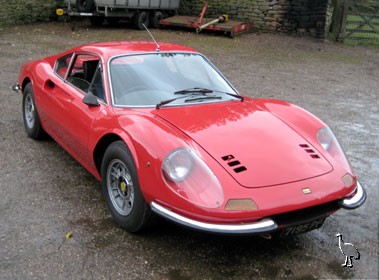Automotive Gallery

Heavily influenced by the Dino 206 GT Berlinetta Speciale concept car (a thinly disguised 206 S sports racer) which Pininfarina had unveiled at the 1965 Paris Salon, the roadgoing Dino 206 GT debuted in Turin two years later. Compellingly curvaceous and bodied in aluminium over a tubular steel chassis frame, it seemed a fitting tribute to Enzo Ferrari's late beloved son Alfredino. Boasting all-round, independent double-wishbone suspension, Koni shock absorbers, anti-roll bars and four-wheel disc brakes, the newcomer was the first Maranello production design to feature either rack-and-pinion steering or a mid-mounted engine. Although, the 1987cc 'quad-cam' unit in question was the work of Franco Rocchi, its inspiration came via Alfredino and the legendary Vittorio Jano (who between them had convinced Enzo Ferrari of the inherent engineering merits behind a compact V6 as early as 1956). Developing a quoted 180bhp at 8,000rpm, the free-revving powerplant was allied to five-speed manual transmission and promised a 140mph plus top speed.
However, despite sensational looks and inspired, race-bred handling, the announcement of an even faster variant at the March 1969 Geneva Motor Show saw 206 GT production cease in August 1969 after just 152 cars. Thankfully, its successor - christened the 246 GT on account of its larger 2418cc engine - retained the same sublime Pininfarina styling (albeit draped over a 60mm longer wheelbase). With a quoted 195bhp and 166lbft of torque on tap, it was reputedly capable of 151mph and 0-60mph in 6.8 seconds. To ease manufacture, the revised two-seater utilized a cast-iron cylinder block and steel bodywork. Inheriting its forebear's cabin architecture complete with steeply raked bucket seats, aluminium fascia, suede-topped dashboard and 'chrome fingered' transmission gate, the model typically rode on Cromodora 'bolt on' alloy wheels. Phased in around mid 1971, the final Series III or Tipo E Dino benefited from revised gear ratios and a different fuel supply system (though, little else was changed). Only in production for three years, just 1,431 Series III fixed-roof Dinos are thought to have been made (with RHD markets accounting for a mere 446 cars)
Finished in red with black upholstery, this particular UK supplied example - chassis number 02720 - is variously described by the vendor as being in "good" (bodywork, interior trim) or "excellent" (engine, five-speed manual gearbox) condition, while he notes the paintwork is "good except for one or two runs" and that the electrical equipment is "not perfect but as good as this model ever was". Previously the property of a Concorde pilot, the Ferrari entered the current (reputedly third) ownership on September 8th 1978. Believed but not warranted to have covered some 78,000 miles from new (the earliest of the numerous old MOT certificates on file was issued on August 13th 1978 at 33,590 miles), the 246GT is further understood to have contested the Ferrari Maranello Challenge Series between 1985 - 1990; finishing 3rd-in-class, 2nd-in-class and finally 1st-in-class during 1986, 1987 and 1988 respectively. Whilst competing, the Dino is said to have "never failed" and to have been "maintained to the highest standard".
Reportedly showing some 66,600 miles to its odometer at the time, the two-seater was treated to a bare metal respray and partial re-trim in 1991. The former work included "the fitting of new inner / outer sills and wheelarches", while the latter saw "the seats and carpets refurbished". Since the mid 1990s when Nick Cartwright Specialist Cars began fettling it on an exclusive basis, the Ferrari has apparently received "full services at 69,617, 72,095, 74,068 and 75,514 miles". Benefiting from attention to its engine (new camshafts / followers, HT leads, rejuvenated carburettors etc), brake system (skimmed discs, fresh flexi brake hoses etc), gearbox (new clutch plate, synchro hubs / spyders etc) and rear wheel bearings in January 1997 at 69,000 miles, the 246GT gained a recored radiator a little over four years and three thousand miles later. Riding on Cromodora alloys and offered for sale for the first time in thirty-two years, this tempting Dino is accompanied by a variety of spares: "alternator, front indicator assembly, radiator grille, quarter bumpers and wheels / tyres" as well as "a complete record of all work carried out since September 1978".Image and description kindly supplied by H&H Classic Auctions
Ferrari Dino 246 1971
Advertisment
home | sitemap | automotive books
Copyright © 1997-2025 dropbears ![]()
